When your company is first starting out, email is usually enough to handle your customer requests. But as your company grows, you need a better way to handle those requests coming in before your support team becomes overwhelmed.
That's where a help desk ticketing system can help. It will monitor all of the customer requests that come in, give them a unique ticket number for both you and your customer to track, and help you organize those requests so that you can reach the most important ones first.
If your team is ready to upgrade from email, this guide will help you pick the best free help desk ticketing system.
What is a help desk ticketing system?
A help desk ticketing system is software that organizes customer questions. When someone reaches out — by email, phone, chat, or another system — the system makes a record. This record, or ticket, helps teams track each request until it's solved.
But help desk ticketing systems do more than just track tickets. They often include tools to build answer libraries, set up self-service options, and boost team output. Many also work with other software your team uses, making the whole process smoother.
The benefits of using a help desk ticketing system
While more commonly associated with customer service and IT, a help desk ticketing system can benefit many teams across just about any industry. For instance, departments like human resources (HR) and maintenance also field a large number of requests, and a ticketing system can keep those messages from getting lost in the shuffle.
No matter the use case, the benefits of a help desk ticketing system include:
Better collaboration and transparency: Help desks ensure that everyone on the team knows the status of every issue, and they provide tools that help agents work together without stepping on each other’s toes.
Increased organization and efficiency: Ticketing tools include tagging, categorization, and analytics features that enable you to track performance metrics and trending issues. They also include productivity and automation tools to help teams streamline their operations.
Improved customer experience: Help desk software allows you to provide a better user experience by giving users more agency over how they receive support. Whether it's through self-service options or additional channels like social media, help desks increase customers' access to help.
It benefits everyone when your agents can work together to solve problems without friction, issues are easily tracked and moved through the resolution process without getting lost, and users can find answers on their own terms.
Features to look for in a help desk ticketing system
When shopping for a help desk ticketing system, there are several key features you should look for:
Omnichannel ticketing: If you get customer questions from many different sources, look for a help desk that supports multiple communication channels. That may include email, chat, phone, social media, messaging, and video conferencing, among others.
Collaboration tools: Look for features like internal notes, ticket assignments, reply templates, and the ability to tag colleagues in on a case. These features make it easier to work through the queue as a team.
Self-service options: If you want to help your customers find their own answers, look for ticketing systems with self-service options like knowledge base builders, community forums, and customer portals.
Automation and AI: In addition to basic automations like ticket routing, you may want to look for a ticketing system with AI features like a chatbot or writing assistants. These features help free up your staff to handle those issues that require human expertise.
Reporting: To understand and improve how your team is performing, look for systems that provide reports on the most important metrics for your team (e.g., resolution times, SLAs, customer satisfaction, and agent performance).
Integrations: If you need to pull data from other systems into your help desk to provide better support, look for a ticketing system that can integrate with other tools in your team’s tech stack, such as bug-tracking software, CRM platforms, or ecommerce tools.
Specialized features: Finally, you may want to choose a system that offers features that are specific to your industry or use case. For example, a system focused on the IT services use case may include features for tracking devices like computers or other company-owned equipment.
The 10 best free help desk ticketing systems
There are plenty of ticketing solutions on the market. However, depending on your use case and the type of service you provide, each will have pros and cons. We’ve put together a list of 10 of the best free help desk ticketing systems below, along with suggestions on what types of teams might benefit most from each platform.
1. Help Scout – Best for customer support teams
Help Scout is a help desk platform that focuses on helping teams deliver delightful customer service experiences.
One difference you will notice right away is that we don’t use the term “ticket”; instead, we call customer interactions “conversations.” While this may seem like a strange stance for a help desk, we believe that no customer wants to be a number.
When your customers receive emails sent through Help Scout, they will look like regular emails — no crazy ticket numbers or prompts to reply above the line included.
Inbox
While customers will never see the impersonal side of help desk life, your team will still have everything they need to track and resolve customer issues. The platform supports email, live chat, and social media channels, and all communications are funneled into a shared inbox that can be accessed via your desktop computer or mobile app.
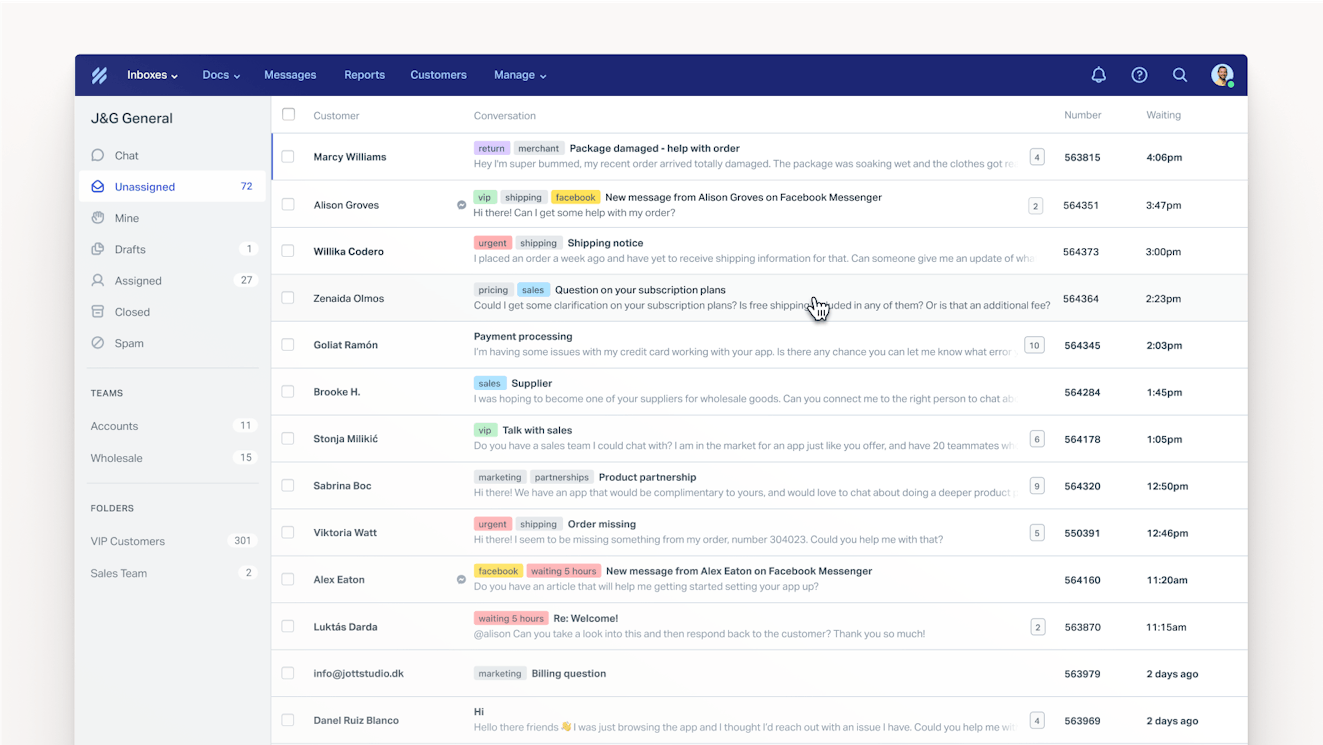
Each conversation within the inbox has a customer profile complete with different types of customer data, such as their name, location, previous conversations, and information pulled from third-party sources. This provides your team with the right information to provide contextual, personalized support.
Collaboration
Help Scout’s inbox offers typical features like the ability to assign conversations to specific agents. It also includes collision detection to ensure customers never receive duplicate responses and internal notes and @mentions for documenting case updates or asking teammates for help.
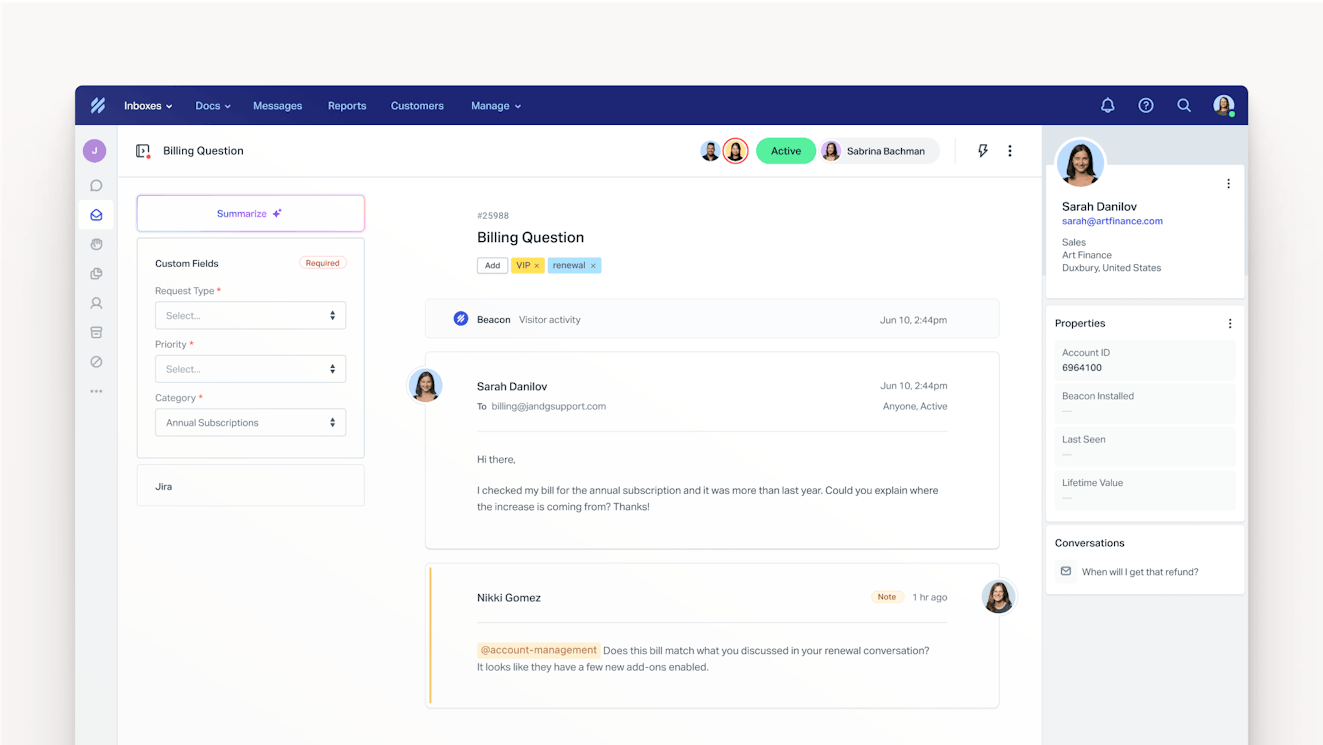
Productivity
The platform also helps your team kick busy work to the curb with productivity tools. Use workflow automations to handle repetitive tasks like conversation routing or tagging high-priority cases. Saved replies are short text snippets that let you respond to FAQs more quickly with a standardized response. Snooze and send later let you decide when to respond to a customer while keeping your queue clear.

Docs
Many customers prefer to help themselves, and with Help Scout’s knowledge base tool, Docs, your customers can do just that. Create a help center with answers to FAQs, how-tos, and videos. Customize the look and feel of your Docs site with your company logo and brand colors.
Once the site is live, make self-service even more accessible by adding a Beacon — Help Scout’s web widget — on any page of your site or within your app. Beacons let you serve up helpful articles in the moment without disturbing your customers’ user experience.

AI
Help your support team do their best work with AI features that boost productivity while freeing up time to focus on more valuable tasks.
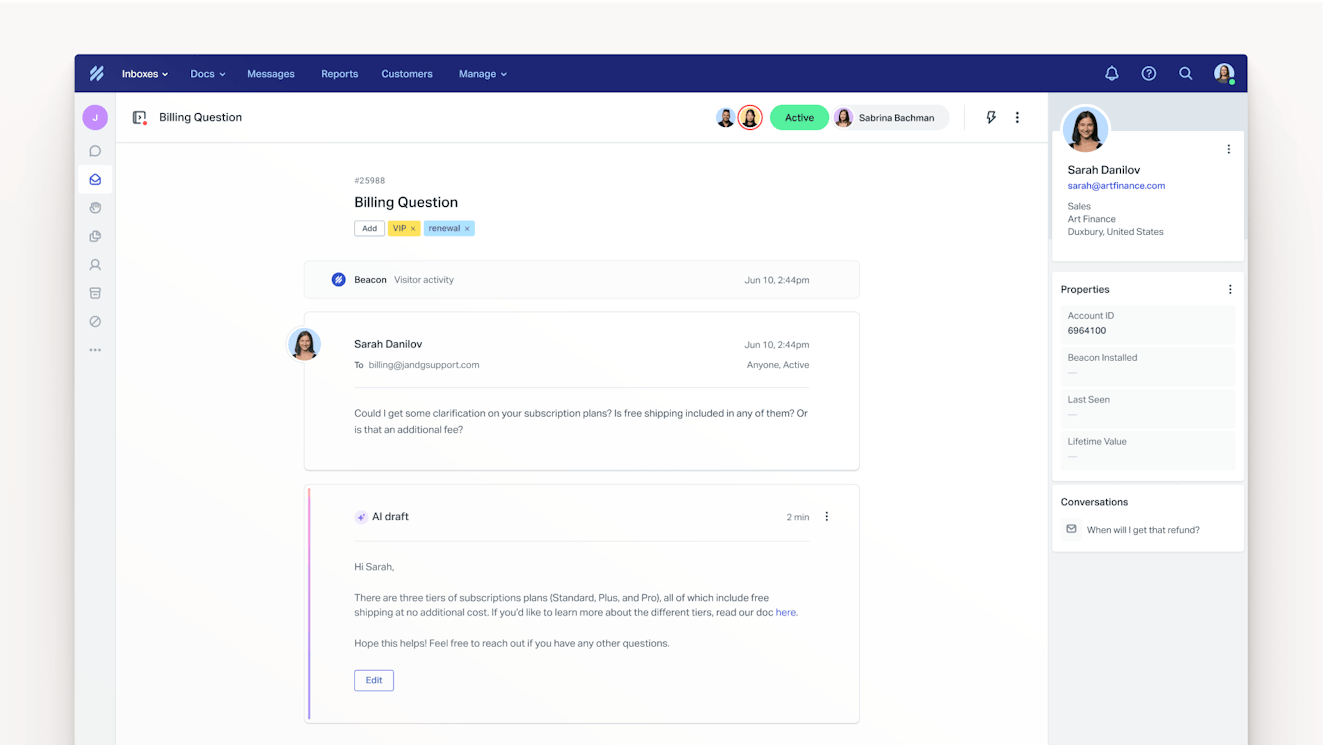
AI Summarize can sum up a long conversation in just a few bullet points, enabling you to get up to speed quickly after an escalation, when handing off a case to a teammate, or when reviewing conversations as part of your quality assurance processes.
AI Assist is a writing assistant that can help with spelling and grammar, translating text into another language, or altering the tone or length of copy composed in any of Help Scout’s editors.
AI Drafts give everyone on your team a head start by drafting a reply to any email on demand. Responses use previous conversations and your knowledge base as source content; simply click AI draft, review for accuracy, and hit send.
Reporting
Back up your decisions with data using Help Scout’s analytics features. You can track metrics like conversation or channel volume, employee performance, or even the success of your Docs site so that you can decide which articles are the most helpful and identify areas for improvement.
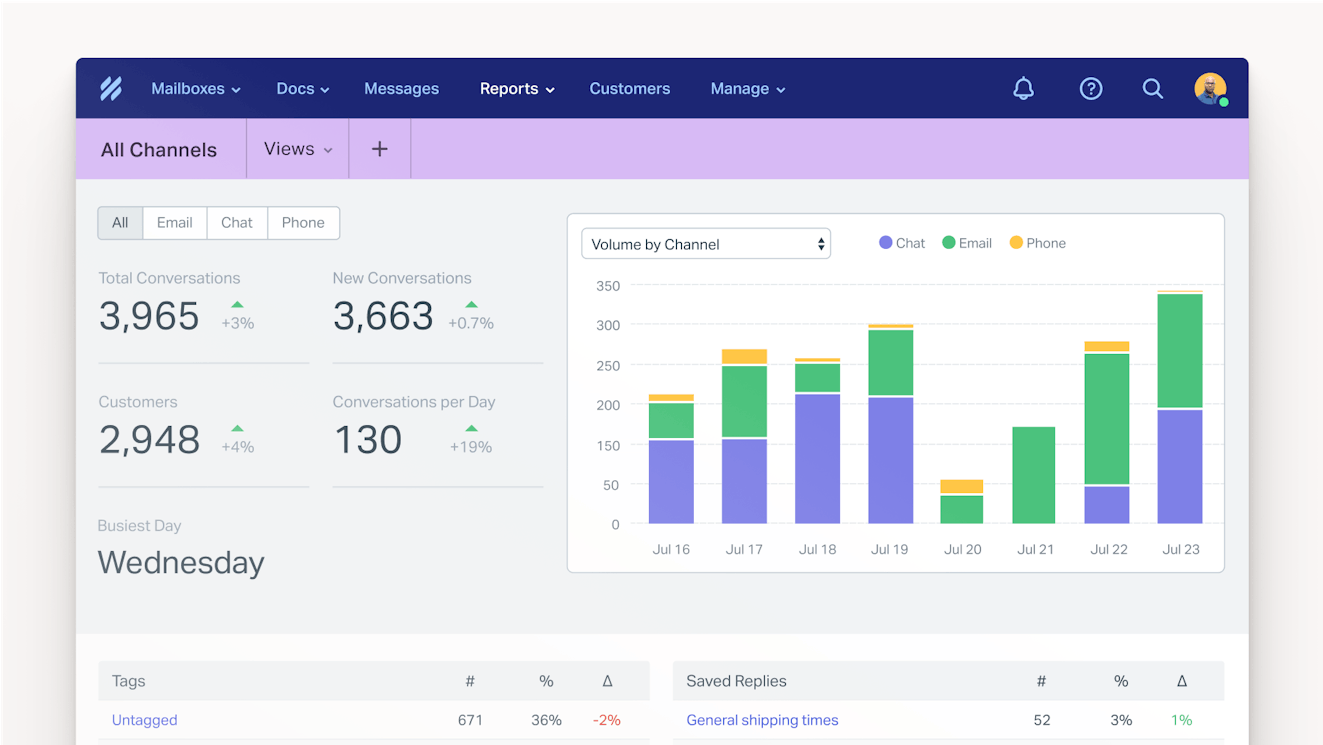
Best-in-class support
Help Scout is an obvious choice for teams interested in a customer-first approach to support. Our support pros are experts at what they do — after all, they're Help Scout users too! We have tons of blog posts and classes to help you get the most out of our software, and the team is available 24/6, ensuring that you always have the care and support you need to be there for your customers.
What's included in the free plan?
Help Scout's free plan includes unlimited users, one shared inbox, one Docs site, one Beacon, ticket assignments and auto-replies, 10 saved replies, 10 views, 10 workflows, 10 proactive messages, 100 tags, reports with up to one month of data, and AI Drafts, Assist, Summarize, and Answers.
2. Google Collaborative Inbox – Best starter ticketing system
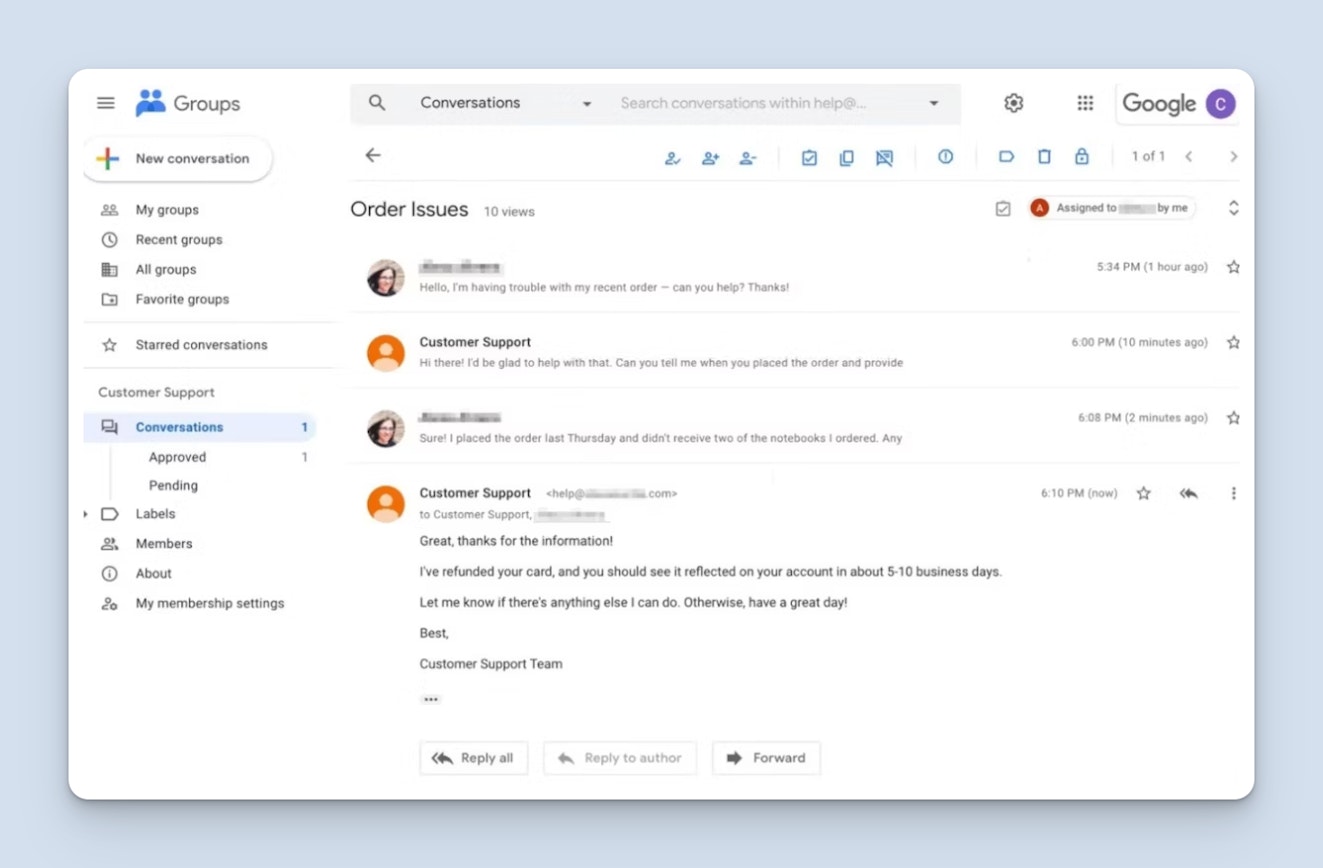
If you’re already using Gmail and want to add some structure to your support efforts, Google Collaborative Inbox can be a good, free starter ticketing system.
The best way to think about Collaborative Inbox is as a shared folder multiple people can access from their own personal email accounts. With it, you’re able to assign conversations to individual group members and add statuses to requests. Group members can do things like mark an issue as a duplicate or as resolved. You can also set permissions for different people or teams who have access to the Collaborative Inbox.
Setting up Collaborative Inbox is relatively simple. You set up the email address, create a Google Group, and then add people to that group. That’s it. Now everyone in the group can respond to emails in the group mailbox without sharing login information.
Google Collaborative Inbox is very basic in functionality, but the thing that really makes it different — assuming you already use Google Workspace — is that you don’t have to sign up for additional software, making it very convenient to get started. It also allows up to 25 members, which is higher than many other free help desk ticketing systems.
What's included in the free plan?
Google Collaborative Inbox is 100% free for Google Workspace subscribers and includes one shared inbox, ticket assignments, ticket statuses, and agent permissions for up to 25 users.
3. Jira Service Management – Best for engineering teams
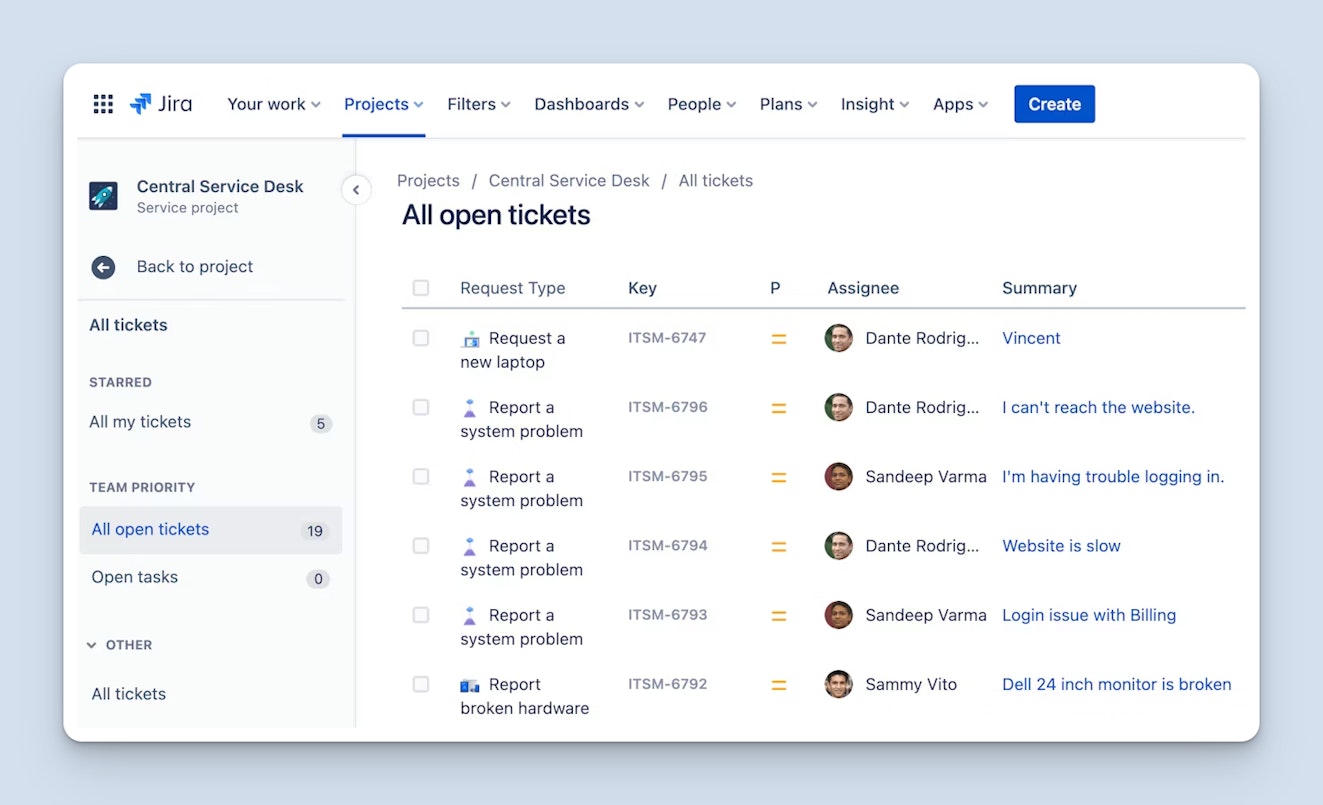
Most SaaS companies are familiar with Jira, Atlassian’s project management software. Beyond typical project management features like product roadmaps, Jira is often used by engineering teams to track development work and bug reports.
If you’re looking to branch into customer or IT support and Jira is part of your tech stack, Atlassian’s help desk, Jira Service Management, makes a lot of sense. It has all of your basic help desk features like ticket tracking, assignments, a knowledge base, and tools for incident, change, and asset management — all wrapped up in a familiar user interface (UI).
Service Management also allows for integrations with a wide range of apps, including messaging services like Microsoft Teams and Slack, or you can code your own custom add-ons using Jira's REST API.
Top features
Service desk for ticket management
Self-service portal w/knowledge base
Incident, change, and asset management tools
AI features
What's included in the free plan?
Jira Service Management's free plan can be used by up to three agents and includes email support, chat support, customer portals, intake forms, workflows, incident templates, and on-call schedules.
4. ProProfs – Best for customer feedback
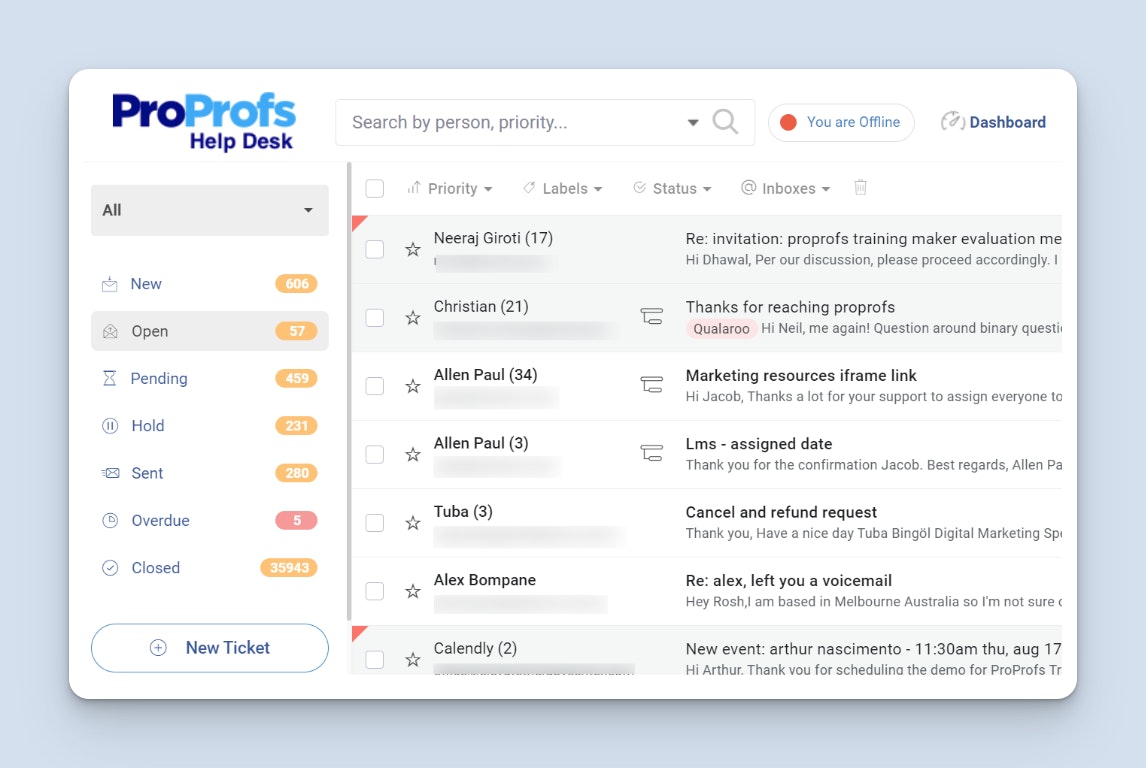
If you are a team of one, ProProfs’ solution can be appealing: Its free plan has everything you need to start supporting customers, like unlimited tickets, canned responses, auto-responders, labels, and even a mobile app for easy support via a portable device.
ProProfs’ help desk is great for both customer support and IT teams alike. Both teams can use the platform to offer multichannel support across email, live chat, and a help center. It also provides collaboration features like internal notes and automation capabilities for a streamlined workflow.
Top features
Unlimited ticketing w/multiple inboxes
Canned responses
Reporting
What's included in the free plan?
ProProfs' free plan works for a single user and includes unlimited tickets, canned responses, and multiple inboxes.
5. Solarwinds – Best for IT service management (ITSM)

Solarwinds is an IT ticketing system built to meet Information Technology Infrastructure Library (ITIL) standards. It includes tools to help teams with problem, incident, change, asset, and knowledge management. It also has tools for time billing and lets you create reports to monitor things like technician performance, asset inventory, and customer survey responses.
Solarwinds' free plan that lets a single user manage incoming email requests with no conversation limits.
There are a few things that make SolarWinds' free plan unique. First, you’re able to install it directly on a Mac, Windows, or Linux-based machine. Second, you can create self-service portals on the free plan, which isn’t common among competitors. Third, you’re able to do automated ticket routing.
Top features
Ticketing software
Knowledge base tool
Custom reporting
Meets ITIL standards
What's included in the free plan?
Solarwinds' free plan includes one user, a self-service portal, ticket automations, Linux compatibility, and no conversation limits.
6. Spiceworks – Best for large IT support teams
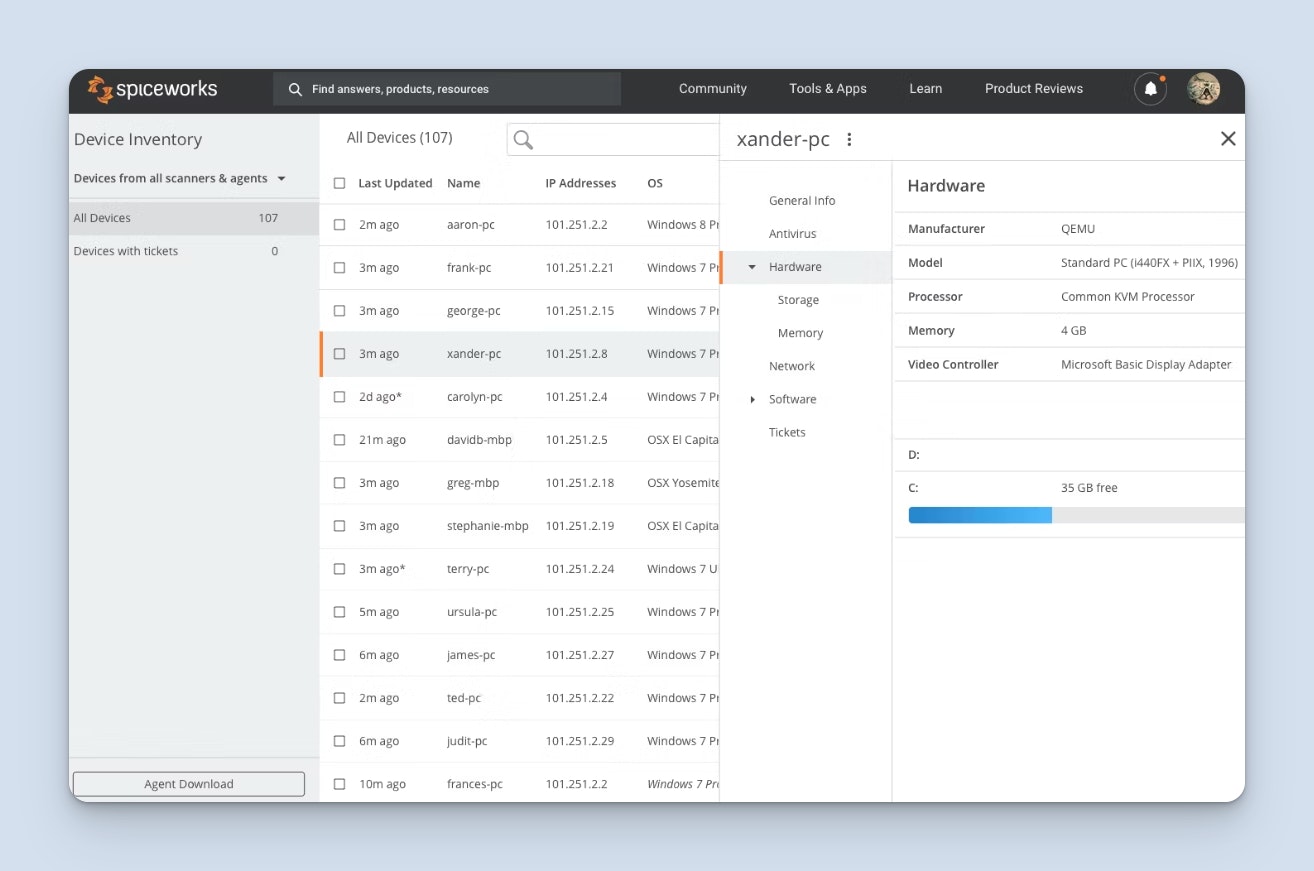
With Spiceworks, you can efficiently manage customer requests through a customizable web portal. You can automatically assign and route tickets based on predefined priorities and categories, helping requests get to the right person right away. Further, you’re able to create automated responses for routine questions to save agents time and improve productivity.
Something a bit unique about Spiceworks is that it has features for inventory management, making it ideal for an IT use case. Along with that, they also offer a customizable knowledge base, which is nice to offer as a self-serve support option.
Along with those features, they also have fairly robust analytics options. You can filter data and create custom reports. You can even connect to Power BI to get more sophisticated with your data. Spiceworks also offers a mobile app, so you can handle requests even when you’re away from your desk.
One thing to note is that Spiceworks can provide its tool for free because it generates revenue from in-app ads. However, if you aren’t bothered by the ads, it makes a lot of sense to save money and take advantage of an entirely free tool.
Top features
Cloud-based ticketing solution
Knowledge base
Reporting features
Mobile app
What's included in the free plan?
Spiceworks is 100% free to use and includes unlimited users, a shared inbox, iOS and Android apps, no conversation limits, automated responses, inventory management, and a help center.
7. Zoho Desk – Best for small businesses
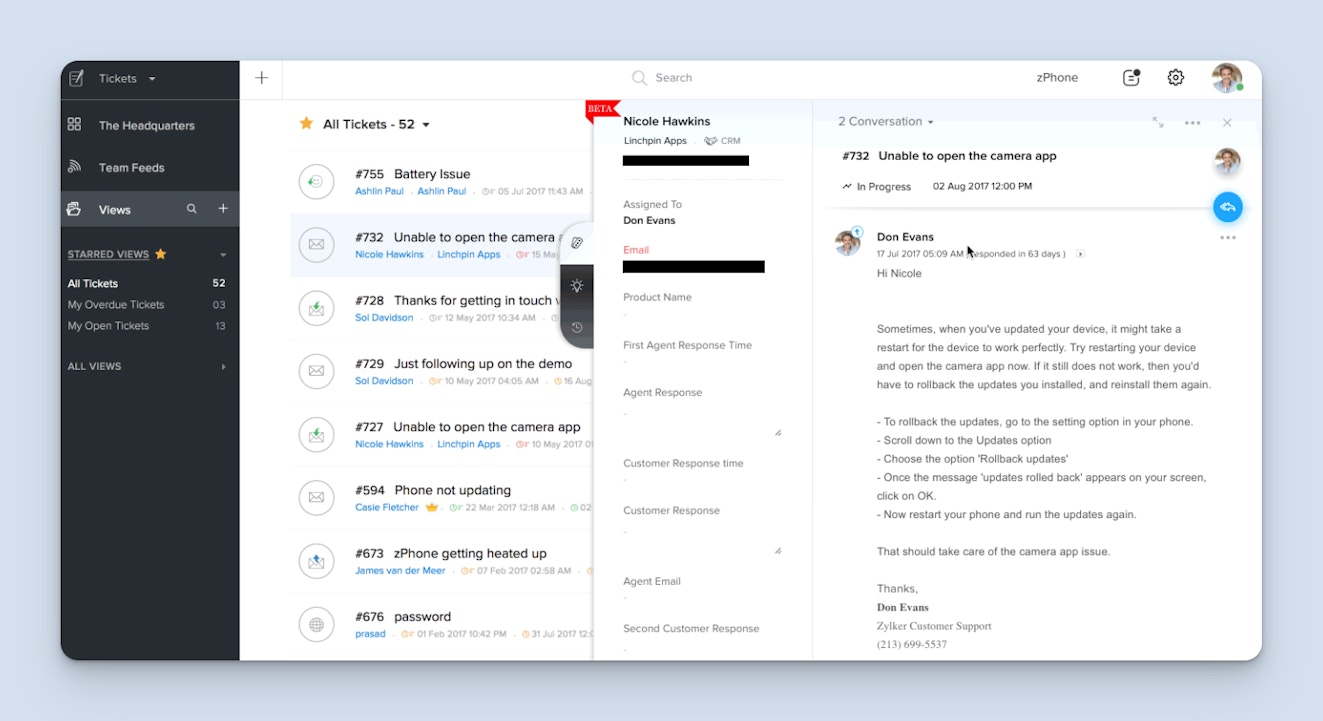
Zoho Desk is a great option for small businesses with a free plan for up to three seats and unlimited tickets. If you’re a high-volume, small team, it could be a good option. On the free plan, you get one shared inbox as well as one help center.
With the shared inbox you can create up to 10 tags to categorize tickets. You can also create two macros, which are canned responses that can help you answer common questions quickly.
Further, you can set up notification rules to let customers and agents know about changes or updates to a request. You can also add customers as contacts and save certain information about them so agents have more context in future interactions.
One feature that’s a bit unique from Zoho is the ability to create a feedback widget and add it to your site. It’s essentially a web form where visitors can leave feedback directly from the page they’re on. You can also create intake forms for support requests, which can be useful for getting certain information upfront, saving agents time when responding.
What's included in the free plan?
Zoho Desk's free plan includes three users, one shared inbox, one help center, two macros, notification rules, a feedback widget, and an intake form.
8. UVdesk – Best for ecommerce companies

UVdesk's free plan offers unlimited seats and a shared inbox for email requests. The platform as a whole is ecommerce-focused and allows users to add a website widget where visitors can submit requests directly. They do this through web extensions for Shopify, Magento 2, Opencart, Prestashop, and WordPress sites.
The free plan also offers some productivity features like saved replies. You can prioritize tickets as well as set a ticket status to keep customers up to date on progress. You’re also able to create custom email templates.
Along with email support, you can create a knowledge base with UVDesk. There’s no article limit, and you can organize articles into different categories to make navigation easier for visitors. Last, you can customize the look of the web widget with color selection or even by adding your own custom CSS.
What's included in the free plan?
UVdesk's free plan includes unlimited users, a knowledge base, saved replies, ticket statuses, and Shopify, Magento 2, Opencart, and Prestashop web extensions.
9. osTicket – Best open-source ticketing system

osTicket is a free, open-source help desk ticketing system that gives teams the ability to provide email support to customers. There’s no seat limit or request limit, and they have some useful productivity features like the ability to create custom columns and queues to keep requests organized.
There’s also a collision detection feature that allows agents to lock a ticket while they’re working on it to avoid another agent chiming in at the same time. This helps avoid duplicate work and stops customers from getting multiple responses, which can be very confusing. You can also set up ticket filters to route requests to different agents and departments based on rules you set in the platform.
One thing that’s fairly unique about osTicket is the tasks feature, which you can use to create different tasks related to specific issues. It’s a great way to create checkpoints and keep track of progress for more complex issues. You can also create a customer portal, giving people access to self-serve support options.
What's included in the free plan?
osTicket is 100% free and includes unlimited users, a self-service portal, collision detection, no conversation limits, custom queues and columns, and task management.
10. Hiver – Best upgrade from Google Collaborative Inbox

Earlier in this article, we mentioned that Google Collaborative Inbox is a great starter help desk ticketing system. But if you've already been using Collaborative Inbox and are looking for an upgrade, Hiver is a good choice. Hiver differs from all of the other options we’ve discussed because it is not a standalone help desk but an extension that works within Gmail.
Ideal for teams of a smaller size, Hiver lets teams create shared inboxes that are visible within the Gmail UI and comes with specialized help desk tools like email assignments, private notes, and collision detection that can’t typically be found in standard email clients.
You can also answer live chat messages from within your inbox, create a knowledge base for self-service, and track trends with reporting dashboards. Hiver has even hopped on the AI train, offering summarize, auto-close, and email template suggestion features to help reduce the amount of effort your team is dedicating to each case.
If you want to stay in Gmail while adding a ton of functionality, Hiver should be at the top of your list.
Top features
Collaboration tools
Live chat and knowledge base builder
AI features
Great for those who love the Gmail UI
What's included in the free plan?
Hiver's free plan that includes unlimited users, one shared inbox, one tag, and one email alias.
Choosing the best help desk ticketing system for your team
There’s no such thing as a “best” system. There is only what is best for your business right now.
Take a moment to consider what problems your team is trying to solve with a help desk ticketing system, what features you need to achieve your desired outcome, and which of the tools above is the best fit for getting you there. Here are some questions to answer to find the right option:
Who is the primary audience you’re serving? Some tools are built for IT support, and some are built for customer support. Knowing who you’ll provide support to and how you’ll provide it can help guide you toward the most ideal option.
How well does the tool scale? This is a big factor to consider. Chances are you might want to upgrade your plan eventually, so pay attention to tools that make leveling up easy to do.
What’s it like to use? Even free tools don’t get used if they’re a pain. Make sure you’re kicking the tires and trying things out. Having something that’s comfortable and intuitive will ensure you get the most value possible out of your selection.
The questions above should help get you started in making a selection. That said, if you want more guidance on selecting a help desk, we have a whole guide on the topic.
Finally, once you've put together a shortlist, consult with colleagues, check out reviews on sites like G2 and Capterra, and consider taking advantage of free trials to really get a feel for whether or not the platforms you like are going to work for your team.







